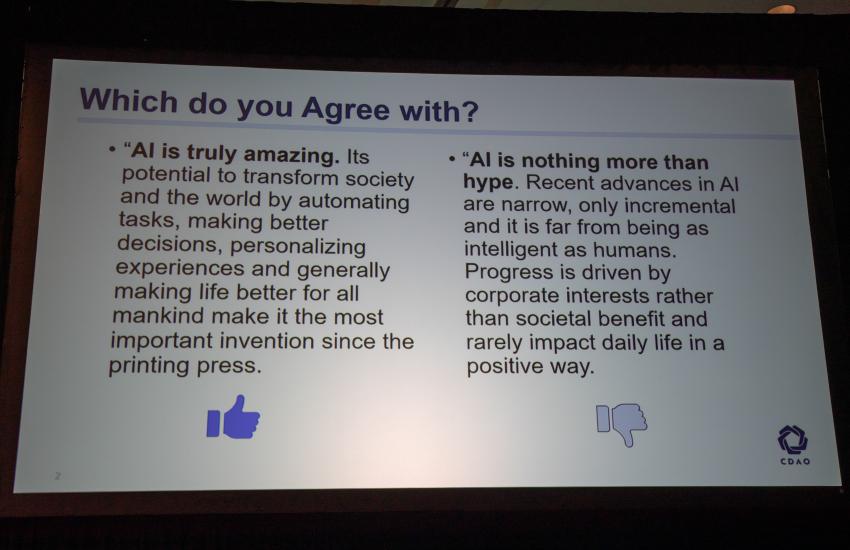Looking Past the AI Hype
Former university faculty member William “Bill” W. Streilein began his presentation with a live audience poll. “I’m going to throw a couple of definitions up here on AI [artificial intelligence] and then you raise your hand depending on which definition you agree with,” he told the TechNet Indo-Pacific 2023 attendees on November 7.
As most listeners did not raise their hand for either of these two definitions: "AI is truly amazing" and "AI is nothing more than hype," Streilein asked how many people believed the true definition was somewhere in the middle. Most finally raised their hand. “I’m in the same boat as you,” he said. “I mean, that’s why I got into this. I went back to school after working in industry for ten years as a software engineer because I really believe AI is amazing. It has the potential to be amazing.”
AI is surrounded by hype, the current chief technology officer at the Department of Defense Chief Digital and Artificial Intelligence Office says, which prevents many from viewing it as a useful tool and technology. "We have to look past the hype to what it actually is.”
AI is a technology that makes sense of data, Streilein explained before diving into the history of the ebbs and flows in the popularity of today’s common term since it was first coined in 1956. “It’s interesting that we’re riding this wave of capability.”
As much as everyone is “excited about AI,” he continued, adversarial nations are perhaps even further interested and more aggressive in approaching the technology to dominate the world.
Though AI capabilities show promise, they remain novel. Derived from generative AI, large language models, for example, entered the scene about a year ago. “They are incredibly impressive at creating human language. They’re trained on human language. They know how to statistically put sentences together … but they’re not always correct, and that is the part that's dangerous,” Streilein said.
With Task Force Lima, an effort created to accept requests for large language model use cases, the goal is to accelerate promising generative AI initiatives. “Our first use cases are large language models because they are most relevant today,” he explained.
The goal with this initiative, the speaker noted, is not to stop progress but rather advance it through appropriate evaluation.
“We want to drive education and bring everybody up to speed on what these actually are,” Streilein continued. “We want to dispel the hype and turn people into critical evaluators of this capability.”
The DoD is currently soliciting models for large language models and will be holding a symposium in February focused on data analytics, AI and the maturity model.
As the DoD takes steps towards progression and modernization, agility is at the core of any new implementation. The current innovative landscape is in a constant shift, requiring continuous deployment and monitoring of technology updates.
Additionally, it’s important to practice ethical usage of AI. “Make sure it’s reliable, it’s equitable, it’s governable, it’s responsible and traceable,” Streilein listed.

With copious amounts of data, the DoD must now focus on high-quality data—data that is usable, findable, visible, accessible, accurate and complete.
Along with enabling data and interoperability, one of the key enablers is expanding digital talent management, the speaker emphasized. “We need to upskill the department, and we need new career paths within the department that enable people to learn how to use data analytics in AI and then get acknowledged for that and follow that throughout their career.”
Within a competitive environment, it is vital to leverage partners as effectively as possible, Streilein said. The DoD is using data as a product, he continued, and moves around in a clockwise fashion to appropriate environments and innovation spaces such as industry. “It is then brought back in and assured and tested before being deployed,” he stated.
This process, though notional, is already seen in the U.S. Army’s Project Linchpin, a collaborative project between Program Executive Office Intelligence, Electronic Warfare and Sensors, Army Futures Command’s Artificial Intelligence Integration Center, the Army Research Laboratory, the Command, Control, Communications, Computers, Cyber, Intelligence, Surveillance and Reconnaissance (C5ISR) Center, and Office of the Secretary of Defense/Chief Data and Artificial Intelligence Office.
“They want to put pipelines of AI capability throughout the Army, and we’re totally behind it,” Streilein said.




Comments